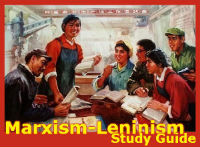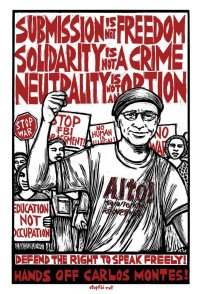The following article was sent to The Marxist-Leninist by the author, Lahore based film-maker and activist Ammar Aziz:
My film thesis research has recently made me visit a piece of land that, despite its significant historical importance , has been brutally ignored in the pages of history. Surrounded by Afghan border, conservative feudal culture and tribal areas that have been in media attention in the recent past due to Taliban, that area is none other then Hashtnagar which stands as its own example in the history of class struggle in Pakistan. Consisting of a cluster of eight villages, Hashtnagar is one of the two divisions of Charsadah district in Pakhtoon Khawah (NWFP) and is one of the province’s most fertile lands known for its sugar cane production. The element of militant armed Socialist struggle differentiates Hashtnagar from the rest of the leftist movements in Pakistan.
 Waving red flags at the roof tops, Socialist symbols painted on the walls, portraits of revolutionary figures, left wing cultural activism and, above all, the daily life of the peasants and workers reflect the liberation that can be felt in the whole ambiance of the area. This liberation is the outcome of the socialist struggle of many decades that has played an important role in shaping the lives and minds of the native people.
Waving red flags at the roof tops, Socialist symbols painted on the walls, portraits of revolutionary figures, left wing cultural activism and, above all, the daily life of the peasants and workers reflect the liberation that can be felt in the whole ambiance of the area. This liberation is the outcome of the socialist struggle of many decades that has played an important role in shaping the lives and minds of the native people.
To understand this revolutionary change, it is important to have a brief overview of the history of peasant’s struggle in NWFP.
The peasantry movement was already active in the province even before the Indo-Pak partition. In the wake of illegal evictions of peasants and unjustified distribution of profits made on the land, the Kissan Jirga in NWFP was created under the leadership of Khan Abdul Jabbar Khan (the younger brother of Khan Abdul Gaffar Khan). The major goals of the Kissan Jirga included protection of the peasants from eviction and oppression by the feudal lords.
The peasants resisted against illegal policies of the government and protested all over the province for their rights. This mass agitation gained popularity in many districts of the NWFP.
After partition, the movement halted for a shorter period of time because of the migration of most of the Hindu peasants to the other side. However, in 1948, the Khans (feudal lords) began mass evictions of peasants from their land, so the peasants from all over the province re-organized their struggle and protested against illegal eviction. In order to protect the rights of the peasants, and to struggle for the convulsion and redistribution of the lands, a new movement with the slogans of ‘land to the tiller’ and ‘total abolition of landlordism” called Hashtnagar Movement came into being in 1948. During 1948, this struggle was suppressed by Qayum Khan government.
After two decades, in the late 60s, the movement entered into a new historical era of agitation against the landlords and ruling elite right after the military dictator Ayub Khan’s land reforms. This was the time when Mazdoor Kissan Party was formed with Afzal Bangash as its leader and gained a massive support throughout the province and especially in Hashtnagar. The MKP gave peasants a clear line of scientific socialism. Afzal Bangash clarified this:
“The movement which has sprung up and is continuing in Hashtnagar is not a new thing. Throughout the world, the peasants have started such movements for their liberation. Such movements have succeeded whenever they have been led by the working class and its philosophy.” (Afzal Bangash speaks: Class Struggle Not a Tribal War)
The movement in Hashtnagar gained widespread support from the Left all over the Pakistan. Some of the major objectives of the movement were to organize rural peasants and create rural bases of peasant power, to eliminate social, political and economic slavery and exploitation of peasants, to set up people’s courts, to increase wages of rural proletariat, distribution of self cultivated lands among the rural laborers and to bring the violence and harassment of feudal lords to an end.
 Most importantly, the struggle resulted in various positive developments. Kissan organizations had formed under MKP and political consciousness of people were raised. Peasants started accepting Marxist ideology. People’s courts were set up and bye laws were enacted. Forced labor, Ejectment and other feudal obligations had stopped. The rural laborers were given houses and wages were increased and moreover the armed resistance of the peasants forced many landowners to flee the area permanently, leaving their lands, which were being distributed among the landless peasantry and are still owned by them.
Most importantly, the struggle resulted in various positive developments. Kissan organizations had formed under MKP and political consciousness of people were raised. Peasants started accepting Marxist ideology. People’s courts were set up and bye laws were enacted. Forced labor, Ejectment and other feudal obligations had stopped. The rural laborers were given houses and wages were increased and moreover the armed resistance of the peasants forced many landowners to flee the area permanently, leaving their lands, which were being distributed among the landless peasantry and are still owned by them.
These achievements, however, were not possible over nights. During the struggle, the revolutionaries had faced strong political opposition, having a backdrop of imperialist interests behind military dictators and conservative politicians.
The MKP, however, kept spreading as a prominent party of the workers and peasants.
Afzal Bangash explained the role of the Mazdoor Kissan Party:
“The party’s main focus was on the peasantry, inspired by the struggles of Chinese,
Vietnamese and African people. It achieved immediate success in the NWFP of Pakistan, where spontaneous struggles between peasants and landlords were already taking place due to Ayub Khan’s land reforms and imposition of farm machinery. The MKP provided the organization and leadership needed by the peasant rebellion and in turn the movement gained tremendous following in the late 1960-s and early 1970s . The movement was not only facing the private armies of the landlords but also attempts by the state to stop it by force” (Afzal Bangash: Class Struggle Not a Tribal War )
It is due to such strong alliance of the right wing, religious fanatics and military that more then 300 comrades lost their lives during the struggle and hundreds were being tortured and jailed. The graves of martyrs are covered with red flags inside the graveyard where people gather in an annual celebration ‘Kaleeza’ in October, paying tribute to their soldiers and also to the great October Revolution that had formed the USSR. There emotional affiliation with the former Soviet Union is quite prominent. Infact, Soviet delegations and progressive people like Dr.Najibullah, who was being inhumanly killed by Taliban, also used to visit the are quite often.
Such massive socialist movements don’t merely bring a change in the objective life but also revolutionize the subjective space of an individual. Apart from the Guerrilla fighters, the Hashtnagar movement has also produced many progressive poets, musicians and artists. People are not alienated from social life, unlike the peasants of the neighborhood areas under conservative feudal and pro-Taliban leadership, and are liberated enough to express their emotions into different mediums. Their attitude towards life is optimistic and they relate their struggle to the International perspective of Socialism. “I believe that Marxism-Leninism is the only solution to the humanity’s problems’, said, Dost Mohammad Bahar, a local worker, poet, singer and activist of the Communist Mazdoor Kissan Party. “My poetry and music is dedicated to the cause of revolution!” Bahar recited his poem ‘Jenny- The Mother of Humanity’ that is dedicated to Karl Marx’s wife Jenny VonWestphalen!
Sparlay, a young student activist and painter, said: “My father was also a communist and he named me Sparlay which means ‘Spring’. I shall follow his path through my drawings.’
According to another research, In Charsadah district, a minor percentage of people send their daughters to the schools and among those the majority is of those who are attached with the movement or the party. This proves that in spite of the dominant Pakhtun culture, patriarchal values don’t exist among the revolutionary cadres of the area. Today, two parties are mainly active there, the MKP and the Communist Mazdoor Kissan Party which was formed as a merger between the Communist Party of Pakistan (CPP) and MKP in the 90s.
Hashtnagar, being a society that has achieved social and cultural liberation through class struggle, gives a new ray of hope to the Lost Left in Pakistan, the left that has started disowning the ideological roots of Marxism-Leninism after the obliteration of the Socialist Bloc in the world. I have no doubt in saying that there would be a time when the echo of its revolutionary songs, words of people’s poetry and color of weaving red flags would overcome the screams of violence, oppression and class system in Pakistan.

















First respect for this journalism! Great and Good Work Ammar Aziz and The Marxist Leninist! I’m too poor of an American wage slave to help with money, but I’m very helped in information by your work and work myself to use it in the cause of transition to socialism.
Reading this reminds me that although after the establishment of Humanity’s first Socialist State with the 1917 Revolution the USSR was faced with the fact of a violently hostile (of course) surrounding capitalist world, given the defeat of post WW I Red revolutionary efforts in Germany, Italy, etc. and knowing that more globally resourced capitalist powers would attack again when felt strong enough, the Soviet Union compromised by abandoning their original emphasis on fighting for other nation’s eminent revolutionary transition and focussed on dealing with ongoing counterrevolutionary operations, delivering Socialism to the people, and preparing for future capitalist challenges with the ideologically difficult doctrine of Socialism in One Country. None the less before WW II, and particularly after the Red Army determined the wars most decisive contests, the Soviet Union delivered admirable democratic self determining and improving socialism to it’s masses and simultaneously fueled and fired global socialist revolutions and States during the Cold War Era. Hashtnagar stands in great example. Where these lights of the socialist idea have been lit (and not all but stomped out such as in my country, the USA, socialist struggles and victories are prevalent around our modern world.
Do I digress?
Workers of the World, Unite!
Hello. Congratulations for the page. We have translated this article to the Galician language (http://estoutrasnotaspoliticas.blogspot.com/2010/06/paquistan-hashtnagar-unha-terra.html).
Communists greetings.